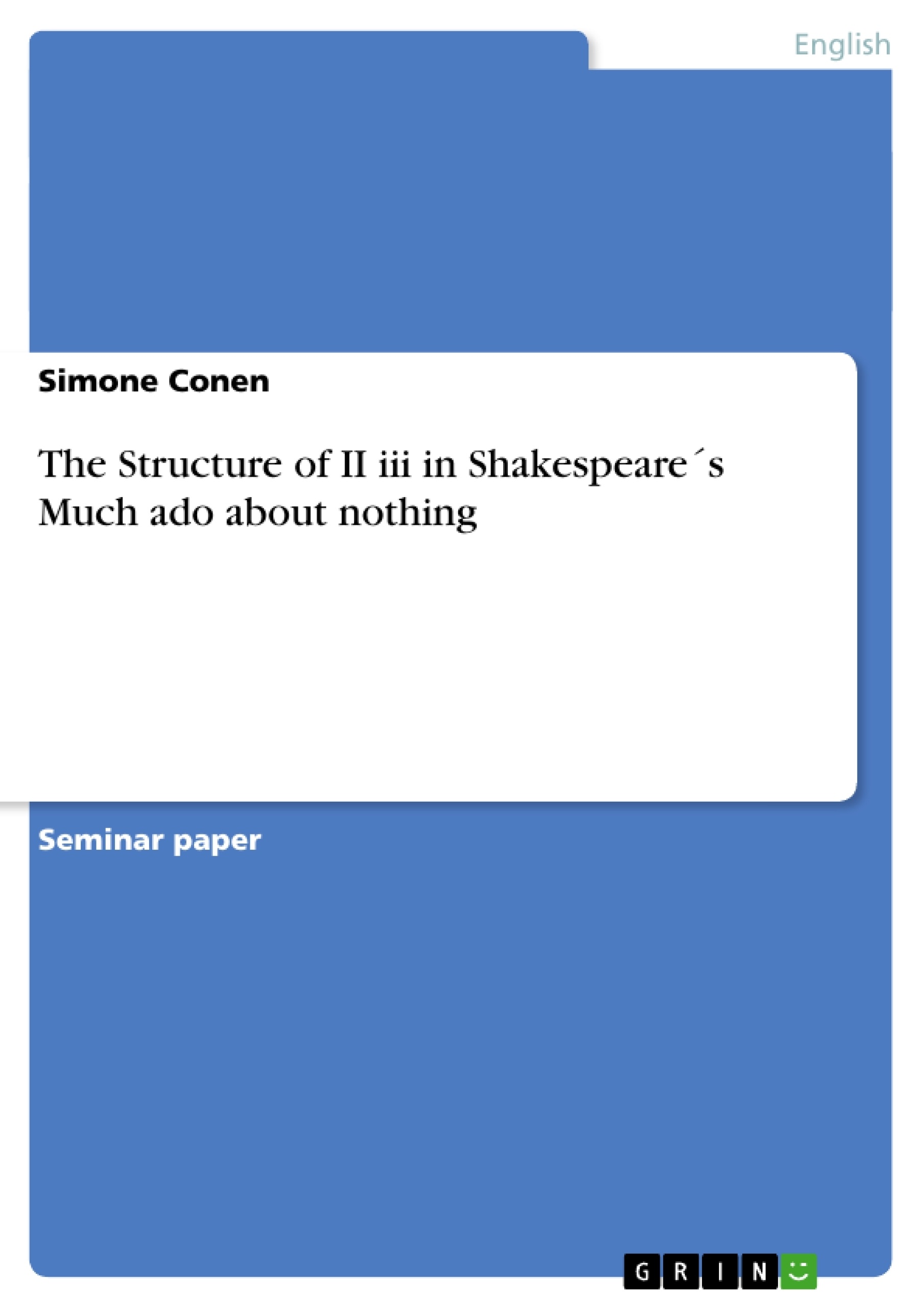William Shakespeare is said to have written his mature comedy Much Ado
About Nothing around 1600.The “nominal main plot”1 of the play is about the
love affair between Hero and Claudio. Nevertheless, the developing Benedick-
Beatrice-liaison, which was rather supposed to be a funny subplot, has a greater
effect on the spectators. The scene in Leonato´s orchard is important and can be
characterized as the decisive point in this context because in the garden, the
foundation stone of the love relationship is laid. Therefore, lots of articles and
books have been written on this particular scene. In this term paper, I want to find
out why the events in the orchard are so fascinating and gripping. 1. Structure of the scene
After having instructed a servant to bring him a book, Benedick speaks aloud
his thoughts on love. He soliloquises that Claudio has changed his behaviour
because he is in love. Benedick is not capable of understanding how a woman can
alter the personality of a man in this extent. He swears to himself that love “shall
never make (him) such a fool”2. In this monologue, Benedick also presents a list
of the qualities which he expects of a perfect woman. These demands seem to be
an unreachable aim for he is really hard to please. Benedick puts up high
standards as a result of his very distinct self-confidence and pride. His soliloquy is
interrupted when Don Pedro, Leonato and Claudio come into the orchard.
Benedick wants to avoid the meeting with them by hiding “in the arbour”3. [...]
1 J.R. Mulryne,Shakespeare:Much Ado About Nothing(London: Edward Arnold Ltd.,1965),p.9.
2 Mary Berry and Michael Clap, ed.,Shakespeare:Much Ado About Nothing(Cambridge: Cambridge University
Press,1998), p.49, 21.
3 Mary Berry and Michael Clap, ed.,Shakespeare:Much Ado About Nothing, p.49 l 28.
Inhaltsverzeichnis (Table of Contents)
- Structure of the scene
- Concept of love
- Linguistic structure
- Comical structure
- The development of Benedick's character
- Realism of Benedick and Beatrice
Zielsetzung und Themenschwerpunkte (Objectives and Key Themes)
This term paper aims to analyze the significance of Scene II iii in Shakespeare's Much Ado About Nothing, specifically focusing on the development of the Benedick-Beatrice relationship. The scene serves as a turning point in the play, marking the foundation of their love story. The paper explores why the events in the orchard are so compelling and captivating.
- The development of the Benedick-Beatrice relationship
- The concept of love and its portrayal in the play
- The use of language and comedic structure in Scene II iii
- The character development of Benedick
- The realism and complexity of the characters
Zusammenfassung der Kapitel (Chapter Summaries)
- The scene begins with Benedick's soliloquy, in which he expresses his skepticism about love and outlines his expectations for an ideal woman. He is interrupted by Don Pedro, Leonato, and Claudio, who deliberately plan to deceive Benedick into believing that Beatrice is in love with him. The scene then focuses on the linguistic and comedic structure of the play, highlighting Benedick's wit and the use of language to create humor and develop the characters.
- This chapter examines the concept of love in the play and its portrayal through the relationship of Benedick and Beatrice. It explores how the characters' initial aversion to love gives way to a new understanding and acceptance of the emotion, culminating in Benedick's declaration of love for Beatrice.
Schlüsselwörter (Keywords)
The key concepts explored in this paper include the development of the Benedick-Beatrice relationship, the portrayal of love, the use of language and comedic structure in Shakespeare's Much Ado About Nothing, character development, and the realism of the characters.
- Quote paper
- Simone Conen (Author), 2000, The Structure of II iii in Shakespeare´s Much ado about nothing, Munich, GRIN Verlag, https://www.hausarbeiten.de/document/17670


